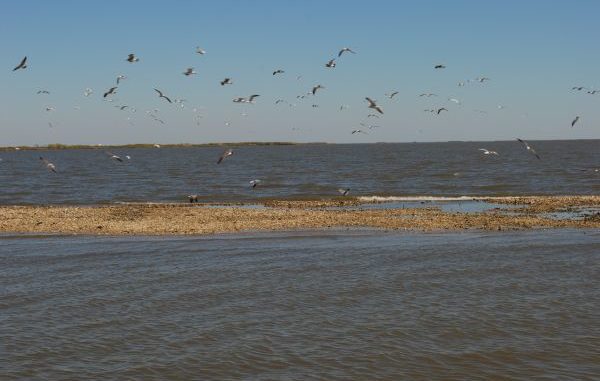
Tete Butte Reef is a natural reef comprised almost entirely of oyster shells. Most of the shell is dead, and much of the crest of the reef is made up of broken shell hash.
Live oysters do occur on the water bottoms surrounding the reef, however.
Few anglers know that the reef is part of a private oyster lease and that the area is subject to disturbance by the leaseholder when he harvests oysters from his lease. This happened a few years ago during a period of peak speckled trout fishing, much to the misinformed indignation of sportsfishermen who had come to consider the prime fishing spot “their own.”
Fortunately, though, disturbance by oyster boats is an only occasional occurrence, and speckled trout fishermen usually have to share it only with each other.
The reef is shaped vaguely like a tree, with the trunk laid in a north-south direction and the bottom of the trunk on the northern end (about 200 yards from the land bank).
The trunk is the highest part of the reef, and often is exposed on low tides.
The part of the reef that would be the crown or leafy part of the tree (if the reef really were a tree), widens and splays out broadly. This part of the reef is not as high and is not typically exposed by low tides.
The sides of the reef gradually slope into 3 to 5 feet of water. Smith estimates the entire reef is approximately a third of a mile long.
Smith’s usual fishing strategy is to begin fishing near the base of the trunk and use his trolling motor to fan cast into the shallow waters of the reef and fish outward.
He likes to fish the west side of the trunk first and then all over the crown and then the east side of the trunk.
When he hits fish, (in his parlance: “When I make contact with them”) he plants his Power-Pole to fish the spot thoroughly, moving again when the fishing action plays out.
He admitted that not all of his fishing at the reef is done from his boat.
“I get out a lot of times and actually walk on top of the reef to fish,” he said. “It’s very firm and easy to walk. Walking the reef is actually much quieter because there is no wave slap on the boat and no trolling motor noise.”
Tete Butte is only one of a number of similar shell reefs located in Gulf of Mexico waters near Marsh Island. Moving eastward from Tete Butte are Pavy Reef, Diamond Reef, Long Reef, Camille Reef and the Shell Keys. Tete Butte is the only one located west of Southwest Pass.
The locations of all the reefs are well-known (Smith calls them “community property”) and marked on most fishing maps.
Tete Butte also has a small satellite reef located to the west and even nearer the shore than the main reef itself. Its location is marked by bunches of easy-to-spot oyster shells on the bank. This reef often offers excellent topwater fishing as well.